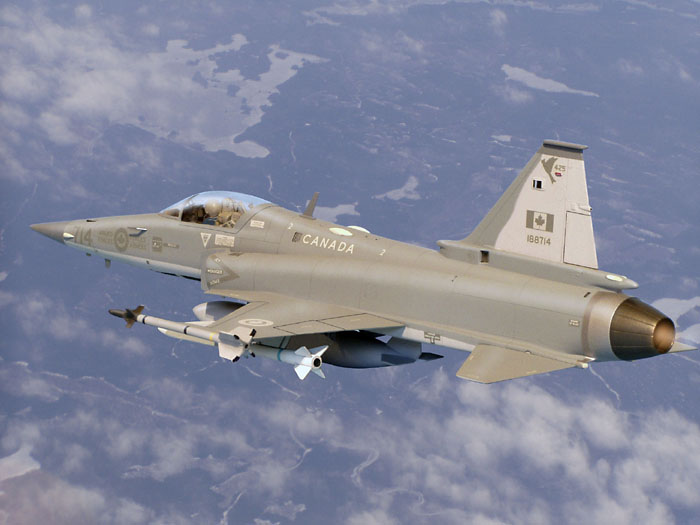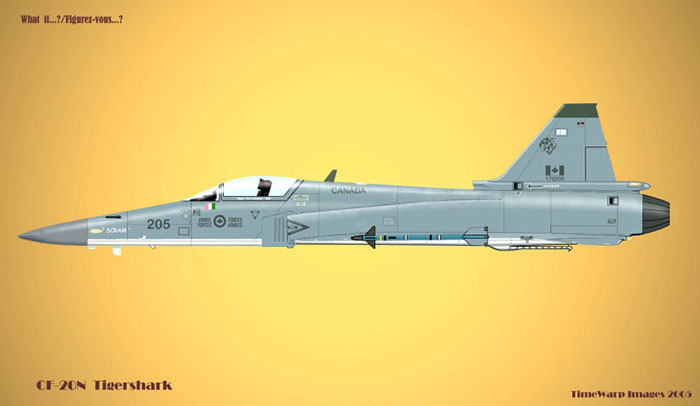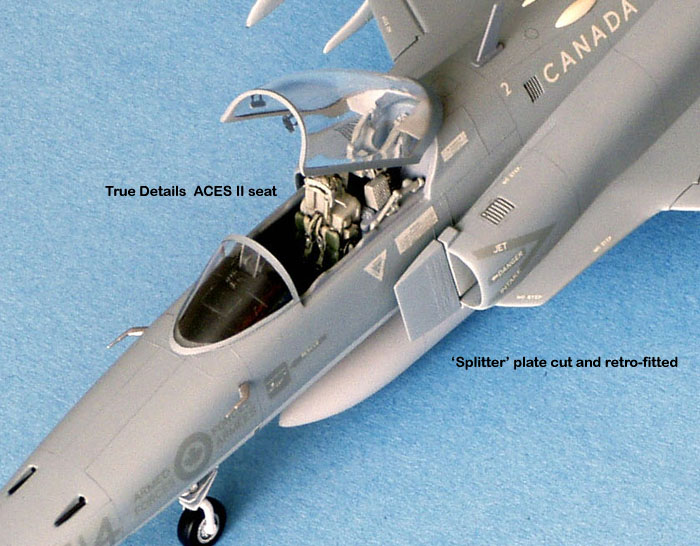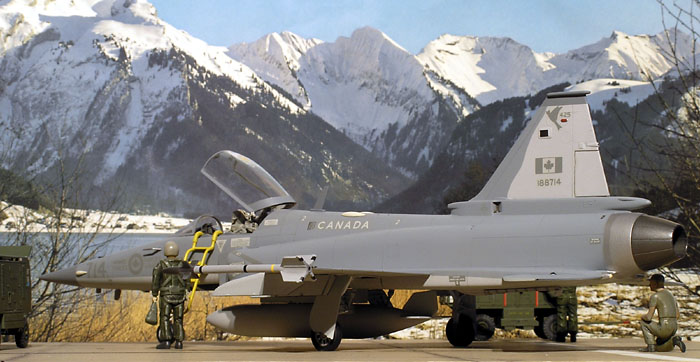|
1/48 scale Monogram "What
If"
CF-20N Tigershark
by Bob Aikens
|
 |
|
CF-20N Tigershark |

ProModeler's 1/48 scale Ar 234C
is available online from
Squadron
Here is my old 1/48 scale
Monogram F-20 Tigershark. I am sure that there are a lot of these
'dead-end' kits in collections everywhere.
When I think about stuff
like this, I get the same sort of feeling as when I see usually out in
the countryside somewhere, a derelict baseball field or an overgrown
soccer pitch. I guess it's a sort of nostalgic sadness for lost fun and
kids running and playing on those fields. It also reminds me that in
certain ways I haven't changed a lot since I was a little boy-modeling
is one of the things that represents a sort of chain of connectivity
with that little person. It's a chain that I am loath to break. In a way
it's sort of like "the Picture of Dorian Gray', but in reverse- a place
where the best of one can go to dwell and prosper, not the worst, as in
Wilde's chilling allegory. But I digress...

The Fighting Fish once thought to be extinct and a dead end of modeling
evolution is beginning to reappear. Only in December it emerged on
'Plastic Pix' as David V.'s F-20 Navy Aggressor with Two Bob's decals.
Some plastic head scientists now believe that this once fossilized form
may be rising from the stashes (someone stop me before I pun again !)
This presentation has it appearing as a "What-if/Figurez-vous' CF-20;
i.e. what if Canada had acquired Northrop's very capable digital jet
instead of the F-18 Hornet.
The kit was issued by Monogram in 1986. I bought one then and remember
well mixing up my own metallic concoction to represent the BMW Ascot
Gray finish on N44671. Twenty years passed until the mysterious links in
the 'chain of chance' began to fall into place once more. If a week is a
long time in politics then 20 years in modeling time might mysteriously
morph into a mere 10 minutes or so...
A local modeling friend
and F-5 aficionado had done up Hasegawa's 1/72 kit in Canadian markings
and low-viz grays and it looked quite nice. Thus the seed was planted
and I snatched up the Mono kit locally for a mere $ 13.00 Cdn. I smiled
inwardly knowing that I had the old (1991) Arrow Graphics CF-18 sheet.
Nations and planets might rise and fall-I was going to finally use those
decals !
However in the late summer of '05, even before I actually had the
kit, I did a digital mock-up of CF-20 (see image) using the old
instruction sheet that with near prodigious foresight I had saved. Thus
encouraged, I was determined to proceed.

People like Bill Gates
must have begun like this.
The kit is very basic in
style, similar to the earlier F-5E. The challenges lie in seam-line
elimination as it features top-to-bottom sections for the forward
fuselage and a rather odd insertion of the tail section (see
illustration scans).
Some blending work must
also be done on the jet intake sections.

After initial puttying
and sanding, Gunze's Mr. Surfacer 1000 was quite helpful covering the
rear seaming.
I painted the topsides
with Pactra Acrylic Enamel A 37 Flat Medium Gray FS 35237 (Imagine how
long that had been sitting around !) The bottom got AeroMaster Light
Ghost Gray 36375. The Pactra paint was thinned with Tamiya acrylic
thinner for spraying and gave an eggshell-type lustre to this flat
paint.Other than masking off for a false canopy the painting was rather
easy.
There are probably many Canadian modelers who know these early Arrow
Graphics (Cdn. subjects) very well-the decal film is certainly thin
enough, but you have to cut out each marking individually as they're not
separated on the sheet. So even if you're using a fresh blade you can
create 'edges' .
An extra glossy surface
seemed to be a good idea so I began by using a unfamiliar product -
Testor's Glosscote Laquer. It has a fine, almost water-like consistency
and sprays on beautifully even. But it seemed that in order to really
gloss up my rather dull paint job, it would have taken a half-pint of
the stuff. My model was now in a semi-gloss state, but was smooth, dry
and hard. Cautiously I carried on with Future applying 3 or 4 light
coats. This worked well and I got good glossy surface. When the decaling
was semi-dry I applied Future with a fine brush on and around the
decaling to try and eliminate the offending 'edges'.

The only other notable thing in the overall construction of this kit
would be the removal and retro-fit of the intake 'splitter' plates. This
was done to ease working on the long seam lines down the front fuselage
sides.
The finished model got a
True Details ACES II seat, a couple of ECM bumps and a VHF antenna. It
represents an aircraft from 425 'Alouette' Sqdn. based at Bagotville,
Quebec.
The panel lines (Ah, yes, the panel lines); most of these fine raised
lines were eliminated during construction. I replaced most of them with
the use of a hard pencil (7H) while the model surface was still in a
matt condition.
It should also be noted that even a car modeler with an instruction
sheet before him could see that I have installed the front landing gear
backwards.. this is indeed a humbling hobby.
Sure, this whole item
has a rather whimsical tone-that's just how serious stuff turns out
sometimes. But I'd like to finish on a more sober note; F-20 GI-1001
crashed during a practice demonstration at Goose Bay , in the northern
part of the province where I live, 14 May 1985. It was to have performed
at the Paris Air Show that June. The curious viewer can find the full
accident report at F-20 Tigershark Home Page...it is compelling, but
grim reading- a sort of testimony to the power of even quite clinical
forensics to hold the attention of this fantasy pilot.
Click the thumbnails below to view larger
images:
Model, Images and Text
Copyright © 2006 by
Bob Aikens
Page Created 06 February, 2006
Last Updated
21 February, 2007
Back to
HyperScale Main Page |
Home
| What's New |
Features |
Gallery |
Reviews |
Reference |
Forum |
Search